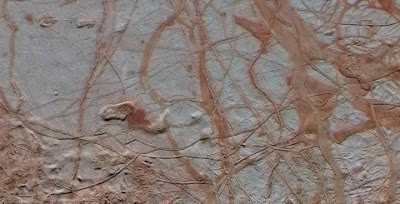An enhanced-color view of Jupiter's moon Europa. (NASA/JPL-Caltech/SETI Institute)
You've got to love a good ocean world. Europa, one of the largest of Jupiter's 67 or more moons, is thought to have an ocean sloshing around beneath its icy crust — and scientists have high hopes that it might harbor (or at least be a suitable environment for) some sort of life. If Europa's rocky core interacts with its ocean in the right way to produce life-giving chemicals, the place could be teeming with strange alien microbes, or even something a little more complex.
A new study in the journal Geophysical Research Letters — based on models made back on Earth — supports this hypothesis. NASA scientists modeled how much hydrogen and oxygen the moon could realistically produce on its own without volcanic activity and found that the ratio between the two elements was roughly the same as it is on Earth.
"We're studying an alien ocean using methods developed to understand the movement of energy and nutrients in Earth's own systems," lead study author Steve Vance, a planetary scientist at NASA's Jet Propulsion Laboratory (JPL), said in a statement. "The cycling of oxygen and hydrogen in Europa's ocean will be a major driver for Europa's ocean chemistry and any life there, just as it is on Earth."
On Earth, the ocean makes hydrogen through a process called serpentinization. The salty water of the sea slithers into cracks in the rocky crust of the Earth, interacting with the minerals in the stone. The resulting chemical reactions fill the water with heat and hydrogen — two very important ingredients for life. The first portion of the new study focused on how many of the cracks that facilitate this process might have formed on Europa as the moon aged and cooled, and how much activity might go on there. On Earth, these cracks penetrate about three miles below the sea floor, but the researchers suspect they go five times as deep on Europa.
But hydrogen on its own isn't enough. The scientists also tried to calculate how much oxygen — which can react with hydrogen — would be available in the ocean.
"The oxidants from the ice are like the positive terminal of a battery, and the chemicals from the seafloor, called reductants, are like the negative terminal. Whether or not life and biological processes complete the circuit is part of what motivates our exploration of Europa," co-author Kevin Hand of JPL said in a statement.
Hand and Vance's models suggest that Europa, which produces elements like oxygen at its surface when Jupiter's radiation splits up water ice molecules, cycles enough oxygen down into the ocean to make that hydrogen useful.
This work is all based on mathematical modeling instead of direct observation. We won't know for certain how abundant these and other elements are on Europa until we take a closer look. In fact, we don't even know whether Europa would need to rely on these passive processes to support life — it's possible that volcanic activity rages beneath the surface and sends hot, mineral-filled water straight into the moon's ocean. These mysteries will hopefully start to be solved in a decade or so, when NASA sends a probe to visit the alien moon.
Read More:
Pluto’s moon may have had an ocean once
Why dying stars may be a good place to look for alien life
Scientists want to send a fish-like ‘soft robot’ to swim the oceans of Europa
More evidence that Jupiter kicked ancient planets out of the solar system
Life in the ocean’s darkest depths is even weirder than scientists thought



Комментариев нет:
Отправить комментарий